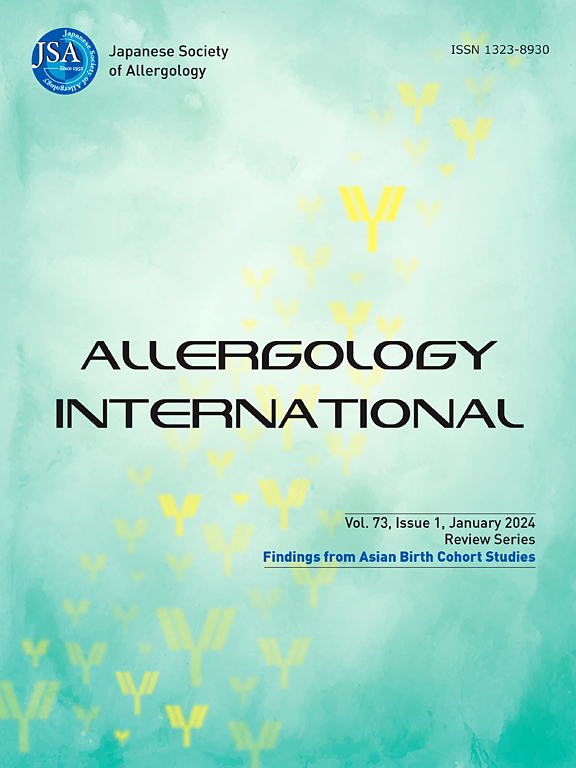Recent advances in the diagnosis and treatment of DIHS/DRESS in 2025
IF 6.2
2区 医学
Q1 ALLERGY
引用次数: 0
Abstract
Drug-induced hypersensitivity syndrome (DIHS) or drug reaction with eosinophilia and systemic symptoms (DRESS) is a severe drug reaction characterized by a range of clinical manifestations. These range from mild cases resolving upon cessation of the causative drug to severe cases involving complex disease progression and potential fatality. A hallmark of DIHS/DRESS is the sequential reactivation of herpesviruses, particularly human herpesvirus 6 (HHV-6), during the disease course, contributing to recurrent symptoms. Viral reactivation can lead to critical complications, including infectious DIHS/DRESS-associated complications (iDACs) and autoimmune sequelae (aDACs). Managing DIHS/DRESS remains challenging due to its complexity, requiring precise prediction and tailored treatment strategies. Recent studies suggest that early-stage classification using the DIHS/DRESS Severity (DDS) score may help identify refractory cases, including DACs. Furthermore, early intervention with anti-cytomegalovirus (anti-CMV) therapy can mitigate iDACs caused by CMV reactivation, preventing progression to severe CMV-related diseases. Long-term follow-up is crucial, as aDACs can manifest even 3 years postonset. Serial monitoring is recommended, particularly in patients treated with intravenous immunoglobulin or corticosteroid pulse therapy, which are recognized risk factors for aDAC development. This review highlights DIHS/DRESS management strategies, focusing on its clinical features, the role of viral reactivation, and therapeutic interventions.
2025年DIHS/DRESS诊断和治疗的最新进展。
药物性超敏反应综合征(DIHS)或药物反应伴嗜酸性粒细胞增多和全身症状(DRESS)是一种以一系列临床表现为特征的严重药物反应。这些范围从轻度病例在停止致病药物后消退到涉及复杂疾病进展和潜在死亡的严重病例。DIHS/DRESS的一个特征是疱疹病毒,特别是人类疱疹病毒6 (HHV-6)在病程中连续再激活,导致症状复发。病毒再激活可导致严重并发症,包括感染性DIHS/ dress相关并发症(iDACs)和自身免疫性后遗症(aDACs)。由于其复杂性,管理DIHS/DRESS仍然具有挑战性,需要精确的预测和量身定制的治疗策略。最近的研究表明,使用DIHS/DRESS严重程度(DDS)评分的早期分类可能有助于识别包括dac在内的难治性病例。此外,抗巨细胞病毒(anti-CMV)治疗的早期干预可以减轻由巨细胞病毒再激活引起的iDACs,防止进展为严重的巨细胞病毒相关疾病。长期随访至关重要,因为aDACs甚至可以在发病后3年出现。建议进行连续监测,特别是在接受静脉注射免疫球蛋白或皮质类固醇脉冲治疗的患者中,这是公认的aDAC发展的危险因素。本文综述了DIHS/DRESS的管理策略,重点介绍了其临床特征、病毒再激活的作用和治疗干预措施。
本文章由计算机程序翻译,如有差异,请以英文原文为准。
求助全文
约1分钟内获得全文
求助全文
来源期刊

Allergology International
ALLERGY-IMMUNOLOGY
CiteScore
12.60
自引率
5.90%
发文量
96
审稿时长
29 weeks
期刊介绍:
Allergology International is the official journal of the Japanese Society of Allergology and publishes original papers dealing with the etiology, diagnosis and treatment of allergic and related diseases. Papers may include the study of methods of controlling allergic reactions, human and animal models of hypersensitivity and other aspects of basic and applied clinical allergy in its broadest sense.
The Journal aims to encourage the international exchange of results and encourages authors from all countries to submit papers in the following three categories: Original Articles, Review Articles, and Letters to the Editor.
 求助内容:
求助内容: 应助结果提醒方式:
应助结果提醒方式:


